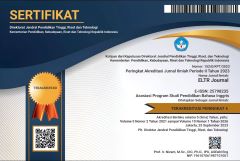PERSONALIZING POTENTIALS OF WEBLOG IN EFL CLASSROOMS
Abstrak terlihat: 456 / PDF terunduh: 513DOI:
https://doi.org/10.37147/eltr.v3i1.61Keywords:
weblog, technology, EFL teachers, EFL classroomsAbstract
A weblog (also called a blog) has been pervasively used as an alternative language learning technology in English as a Foreign Language (EFL) settings. However, there are still limited attempts to shed more lights on the (a) integration of various applications in the blog and (b) how they can be maximized for teaching and learning purposes in the context of Indonesian higher education. Therefore, this study aims to explore issues concerning the use of a tutor blog run in an English Education Study Program of a private university. The exploration focuses on the potentials of the tutor blog and their relevance to current blogging activities as well as draws on related literature and reflective experiences in utilizing the blog in EFL classrooms. This study seems to confirm the potentials of the tutor blog, as asserted by Campbell (2003). The analysis also reveals some possibilities of integrating the blog into other technological applications, which should be beneficial for pre-service and in-service EFL teachers who wish to utilize blogs to support their pedagogical agendas. The study concludes with directions for further studies.
Downloads
References
Arneil, S., Holmes, M., & Street, H. (2004). Hot potatoes version 6. Retrieved from: http://hotpot.uvic.ca/hotpot6_help.pdf.
Ary, D., Jacobs, L. C., Irvine, C. K. S., & Walker, D. A. (2019). Introduction to research in education (10th ed.). Boston, MA: Cengage.
Aydin, S. (2014). The use of blogs in learning English as a foreign language. Mevlana International Journal of Education (MIJE), 4(1), 244-259.
Blackstone, B., Spiri, J., & Naganuma, N. (2007). Blogs in English language teaching and learning: Pedagogical uses and student responses. Reflections on English Language Teaching, 6(2), 1–20.
Campbell, A. P. (2003). Weblogs for use with ESL classes. The Internet TESL Journal, 9(2). Retrieved from http://iteslj.org/Techniques/Campbell-Weblogs.html
Creative Blog Staff. (2014, May 12). A history of blogging. Retrieved from https://www.creativebloq.com/web-design/history-blogging-51411626
Crystal, D. (2006). Language and the internet (2nd ed.). Cambridge: Cambridge University Press.
Dornyei, Z. (2001). Motivational strategies in the language classroom. Cambridge: Cambridge University Press.
Forber-Pratt, A. J. (2015). “You’re going to do what?” Challenges of autoethnography in the Academy. Qualitative Inquiry, 21(9), 821-835.
Guttler, F. (2011). The use of blog in EFL teaching. BELT Journal, 2(1), 59-68.
Harmer, J. (2007). The practice of English language teaching (4th ed.). Essex: Pearson Education Limited.
Hossain, M. M., & Quinn, R. J. (2012). Advantages and disadvantages of using a blogging activity in a college Euclidean geometry course. International Journal of Computer Technology and Electronics Engineering (IJCTEE), 2(6), 1-8.
Javad, K. H., & Leila, A. A. (2015). Attitudes toward using the internet for language learning: A case of Iranian English teachers and learners. International Journal of Research Studies in Educational Technology, 4(1), 63-78.
Lin, M. H. (2015). Learner-centered blogging: A preliminary investigation of EFL student writers’ experience. Educational Technology & Society, 18(4), 446–458.
Mali, Y. C. G. (2015). Blog as a pedagogical application in learning creative writing. Widya Dharma, 28(1), 48-67.
Mali, Y. C. G. (2016). Integrating technology in Indonesian EFL classrooms: Why not?. Beyond Words, 4(1), 17-26.
Marcus, S. (2010, August 6). A brief history of 9 popular blogging platforms. Retrieved from https://mashable.com/2010/08/05/history-of-blogs/#xZHlnAx70EqN
Mendez, M. (2013). Autoethnography as a research method: Advantages, limitations and criticism. Colomb. Appl. Linguist. J, 15(2), 279-287.
Morgan, A. M. (2009). Issues analysis tasks for year 12 ESL studies in the south Australian curriculum. The Internet TESL Journal, 9(2). Retrieved from http://iteslj.org/Lessons/Morgan-IssuesAnalysis.html
Muhtaris, K., & Ziemke, K. (2015). Amplify: Digital teaching and learning in the K-6 classroom. Portsmouth: Heinemann.
Patton, M. Q. (2002). Qualitative research & evaluation methods (3rd ed.). California: Sage Publications, Inc.
Peery, J. (2013). Ipads, QR codes, the big 15, and screencast-o-matic: It’s all happening in a library media center. Library Media Connection, 34-37.
Powell, L. M., & Wimmer, H. (2014). Evaluating the effectiveness of self-created student screencasts as a tool to increase student learning outcomes in a hands-on computer programming course. Proceedings of the Information Systems Educators Conference, 31(3061), 1-7.
Purcell, K., Buchanan, J., & Friedrich, L. (2013, July 16). The impact of digital tools on student writing and how writing is taught in schools. Retrieved from http://www.pewinternet.org/2013/07/16/the-impact-of-digital-tools-on student-writing-and-how-writing-is-taught-in-schools/
Ray, B. B., & Hocutt, M. M. (2006). Teacher-created, teacher-centered weblogs: Perceptions and practices. Journal of Computing in Teacher Education, 23(1), 11-18.
Thompson, C. (2006, February 10). The early years. Retrieved from http://nymag.com/news/media/15971/.
Tseng, M. C. (2008). The use of blogs in English classes for medicine-related majors. Chang Gung Journal of Humanities and Social Sciences, 1(1), 167-187.
Vasconcelos, E. F. D. S. (2011). "I can see you": An autoethnography of my teacher-student self. The Qualitative Report, 16(2), 415-440.
Wahyudi, R. (2016). Becoming an empowered EFL teacher: A critical self-reflection of professional development. ELTED, 20, 83-96.
Ward, J. M. (2004). Blog assisted language learning (BALL): Push button publishing for the pupils. TEFL Web Journal, 3(1), 1-16.
Wichadee, S. (2014). Factors related to students’ performance of hybrid learning in an English language course. International Journal of Distance Education Technologies, 12(1), 74-90.
Widodo, H. P., Budi, A. B., & Wijayanti, F. (2016). Poetry writing 2.0: Learning to write creatively in a blended language learning environment. Electronic Journal of Foreign Language Teaching, 13(1), 30-48.
Winke, P. & MacGregor, D. (2001). Review of hot potatoes. Language Learning & Technology, 5(2), 28-33.
Yang, S. H. (2009). Using blogs to enhance critical reflection community of practice. Educational Technology & Society, 12(2), 11-21.
Yuen, G. O. M., & Cheung, W. S. (2013). What students like and dislike about blogs: A two-case study. New Horizons in Education, 61(2), 93-110.
Downloads
Published
How to Cite
Issue
Section
License
Copyright (c) 2019 Yustinus Calvin Gai Mali

This work is licensed under a Creative Commons Attribution-ShareAlike 4.0 International License.













